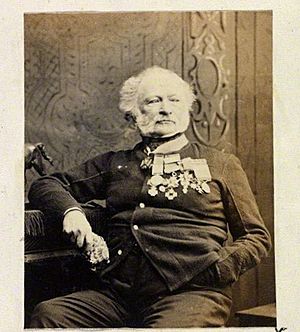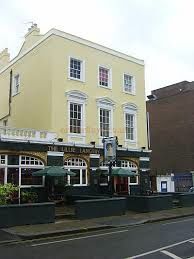John Scott Lillie facts for kids
Quick facts for kids
Sir John Scott Lillie
|
|
|---|---|

Sir John Scott Lillie by Camille Silvy c.1862
|
|
| Born | 1790 Ireland |
| Died | 1868 (aged 78) Kensington, London, England |
| Buried |
Brompton Cemetery
|
| Allegiance | |
| Service/ |
Army |
| Years of service | 1807–1818 (1855) |
| Rank | Lieutenant-Colonel (UK) Major-General (Portugal) |
| Unit | 6th Warwickshire Regiment, Grenadier Guards, |
| Commands held | 7th Cacadores |
| Battles/wars | Peninsular War, Battle of Bussaco, Torres Vedras Lines, Battle of the Pyrenees, Battle of Nivelle, Battle of Orthez, Battle of Toulouse (1814) |
| Awards | Army Gold Cross, Decoration of The Lily (France), Military General Service Medal, Knight Bachelor, Companion of the Bath |
| Relations | General Scott, Duchess of Portland and Viscountess Canning |
| Other work | Deputy Lieutenant of the County of Middlesex Justice of the peace Chairman of Middlesex Quarter Sessions, shareholder in the Hammersmith Bridge Co., Kensington Canal Co., political writer, parliamentary candidate, Patent holder. |
Sir John Scott Lillie (1790 – 29 June 1868) was a brave officer in both the British Army and the Portuguese Army. He fought in the Peninsular War (1808–1814) against Napoleon's forces. Beyond his military career, he was also a landowner, a businessman, and an inventor. He held important public roles, like being a Deputy Lieutenant for Middlesex and a Justice of the peace. He was also a freemason, a politician who supported change, and an early advocate for animal welfare.
Contents
Early Life and Family
John Lillie was born in Ireland in 1790. He was the oldest son of Philip Lillie and Alicia Stafford. His family owned land in Ireland and England. After finishing his education, John decided to join the British Army.
In 1820, after being wounded three times in the war, Lillie married Louisa Sutherland. They had a daughter and three sons. One of his sons, George Arthur Howard, became a Buddhist while serving as an officer in India.
Military Adventures
Lillie joined the 6th Warwickshire Regiment in 1807. The next year, he went to Portugal with the British forces. At just 19, he became a captain in the Lusitanian Legion of the Portuguese Army. This was an elite group of light infantry soldiers called the Caçadores.
He fought in many battles to defend Portugal. In 1810, he was promoted to lieutenant. He fought at the Battle of Bussaco and helped with the retreat to the Torres Vedras Lines. In 1812, at the Battle of Salamanca, he was said to have captured the flag of a French regiment himself.
As commander of the 7th Caçadores, he led his troops in several major battles. These included the Battle of the Pyrenees, Battle of Nivelle (1813), Battle of Orthez (1814), and the Battle of Toulouse (1814). At Toulouse, he was seriously wounded for the third time and was left for dead for two days.
For his bravery, he received several awards. The French gave him the Decoration of The Lily. The British awarded him the Army Gold Cross and later the Military General Service Medal. In 1816, he was knighted, becoming "Sir John." In 1831, he was made a Companion of the Bath. The same year, the King of Portugal promoted him to major general in the Portuguese Army. He retired from the British Army in 1855 as a lieutenant colonel. He wrote down his experiences from the war.
Businessman and Inventor
After the war, Sir John was on half-pay from the army due to his injuries. He decided to use his energy in London. In 1822, he bought a large house called 'the Hermitage' with a fourteen-acre estate in North End, Fulham.
At this time, there was a lot of interest in building canals and improving transport. Lillie was already an investor in the Hammersmith Bridge project. He then became a major investor in the Kensington Canal company. His plan was to connect the new Hammersmith river crossing with the village of Brompton, which was closer to London.
In 1825, he gave some of his land for a new public road. This road connected Crown Lane and North End Lane to the Kensington Canal. He also helped build a new canal bridge.
To support the canal and the new wharves, he created more roads. Around 1830, he built the 'North End Brewery' and a tavern. This tavern, built in 1835, became known as the "Lillie Arms" to honor his work in developing the area. Today, it's called 'The Lillie Langtry'. The road and bridge he helped create were eventually renamed Lillie Road and Lillie Bridge.
The canal project faced many problems and was not very successful. It was eventually replaced by railways. First, one railway track was laid along the canal. Then, in the 1860s, the canal was filled in, and a second track was added.
In 1837, Sir John Lillie moved with his family to Chelsea, London. Later, in the late 1840s, he moved to Kensington, where he lived until he died.
Amazing Inventions
Sir John Scott Lillie held over 30 Patents for many different inventions. These included machines for kneading dough, tilling fields, and even new types of building materials like stucco. He also designed engines for vehicles on land and water.
In 1836, he designed a power unit for carriages and barges. His military background also influenced his inventions. He designed the 'Lillie Rifle battery,' which was an early type of machine gun.
He also worked on making better roads. He designed a system using layers of wood and asphalt to make roads last longer and be weather-proof. He received a patent for this idea. In 1863, he helped start the 'Institute of Inventors' and was the chairman at their first meeting.
Public Service and Activism
While living in North End, Fulham, Lillie became involved in public life. He was interested in the debate about parliamentary reform, which aimed to change how Parliament worked. In 1831, he wrote a pamphlet about sharing power in Parliament and stopping corruption in elections.
He was connected with the Whig political party. In 1835, Sir John Lillie ran for election in King's Lynn, but he did not win. His Irish background led him to support Catholic emancipation, which gave more rights to Catholics. He was a friend and supporter of the famous Irish statesman Daniel O'Connell.
As a magistrate (a type of judge), Sir John helped improve conditions at Hanwell Asylum in 1840. He reported that patients were getting hurt because they were not being properly looked after. This issue was then discussed in newspapers and medical journals.
Even when he was very old, Lillie spoke out against the cruel treatment of animals in experiments. He wrote a letter to a medical journal in 1861 about this. He also continued to write to the press about military topics in 1866.
Sir John Lillie's first wife, Louisa, passed away in 1860. He then married Elisabeth Hannah Carew in Paris in 1862. She survived him. He died in Kensington on June 29, 1868, and was buried at Brompton Cemetery.
Awards and Honors
- The Most Honourable Order of the Bath, CB (Great Britain)
- Army Gold Cross (Great Britain), for Pyrenees, Nivelle, Orthez, Toulouse
- Military General Service (Great Britain), for Battle of Roliça, Battle of Vimeiro, Bussaco, Battle of Badajoz (1812), Battle of Salamanca, Battle of Vitoria and Battle of Nive
- Order of the Tower and Sword, Knight's breast Badge (Portugal)
- Commander's Cross for Five Actions (Portugal): Pyrenees, Nivelle, Nive, Orthez and Toulouse
- Campaign Cross for 4 Years (Portugal)
- Decoration of the Lily (France)
Heroic Rescue
In 1827, Lillie was on a boat in the Thames River when it crashed near the Tower of London. The boat quickly broke apart and sank, leaving everyone in the water. Other boats quickly came to rescue people. Sir John, who was a strong swimmer, helped a nine-year-old boy who couldn't swim. Both were rescued and taken to safety. For this brave act, Sir John Scott Lillie was honored by the Royal Humane Society in January 1827.
Places Named After Lillie
- Lillie Road (Fulham)
- Lillie Bridge, rebuilt in 1866
- Lillie Bridge Grounds, famous sports grounds in Fulham
- Lillie Rec, a park at the junction with the Fulham Palace Road
- Lillie Bridge Railway Depot, an engineering workshop for London Underground
- Lillie Hall, a building that was once a roller-skating rink and then a car showroom
- The Lillie Arms, a public house built in 1835, now called 'Lillie Langtry'
- The Lillie Rifle battery (his invention)
- Sir John Lillie Primary School (Fulham)
See also



